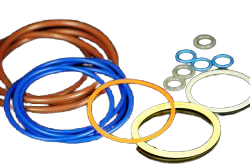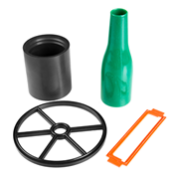AS568 O-Rings
Whatever your o-ring requirements, Ace Seal has got you covered. Check out our popular line of AS568 o-rings below.
To get started on customized O-rings, use the filters below to find the AS568 o-ring option you need, defined by inside diameter (ID) and the cross section (CS). Then, click on the link to specify the material, hardness, and color your application requires and request a custom quote.
Request a quote on custom AS568 rubber O-rings, or contact us discuss your unique needs.
Custom and Standard AS568 O-Rings
Ace Seal offers extensive o-ring manufacturing capabilities including a comprehensive selection of elastomers and sizes for standard imperial, metric, and special applications. We provide O-rings for practically any application and offer several design resources to help you design a custom AS568 O-ring seal that meets your exact requirements.
With Ace Seal, you’re not limited to common industry O-ring sizes. We manufacture standard and custom O-rings in AS568 sizes and profiles to accommodate your static or dynamic applications.
Tools for Selecting and Customizing Rubber O-rings
Each type of elastomer has a different operating temperature range and selecting the right material is critical to O ring performance. Use our temperature compatibility chart for assistance finding an elastomer that meets your operating temperature requirements. For further detail, see our material properties comparison chart that grades each elastomer on a range of factors including chemical resistance, tear resistance, chemical resistance, tensile strength and more.
Dovetail grooves help hold orings in place during installation and maintenance and are recommended for O-rings that have a larger cross-section. Visit our groove design page for additional information on measurements for O-ring groove depth, width and radius.
What Is the Difference Between Gaskets Vs. O-Rings?
Gaskets and o rings have similar constructions, but there are differences in their material and shape. A gasket is usually a flat sheet made from a variety of materials, including cork, rubber, plastic, and more. There are several types of gaskets, some of which require a flat flange and a bolted joint.
Rubber O-ring seals, on the other hand, have a simple circular design with rounded edges instead of being flat. They are made using a variety of flexible elastomers and are precisely molded to fit into specific profiles.
O-rings also serve different purposes than gaskets. Both prevent fluids from escaping, but o rings are typically used for hydraulic and other high-pressure applications where a regular gasket made of cork or rubber would not hold up. Rubber O-rings are well-suited for both static and dynamic applications and tend to be cost-effective.
Common Causes of O-Ring Failure and Prevention Methods
O-ring failure is often caused by a combination of factors including improper installation, allowing for too much or too little compression in the gland design, inadequate lubrication, abrasion, or using an O-ring seal that is the incorrect size or type of elastomer for your application. Here are a few common sources of rubber oring failure and what you can do to prevent issues.
Abrasion
Abrasion is common cause of o ring failure and can result from an improper finish of the surface in dynamic contact with the O-ring. If the surface around the O-ring is too abrasive, or even too smooth, the surface will be unable to hold lubricant. Issues with O-ring abrasion can also occur when a system fluid is not providing proper lubrication, the system fluid contains abrasive particles, or the operating environment involves excessive temperatures.
Solutions to this problem include adding proper surface finish and adequately lubricating the O-ring to reduce friction and the risk of wear over time. Another way to prevent abrasion caused by excessive temperatures is to choose an elastomer that is designed to tolerate the operating temperatures where the O-ring is going to be installed. Make sure to review our temperature compatibility chart before selecting an elastomer for your custom AS568 O-ring.
Also check your system fluid regularly for contamination and to ensure that it provides enough lubrication for the O-ring and type of elastomer. If you continue to experience issues, try using a rubber o ring made from an elastomer that provides more abrasion resistance or that is internally lubricated.
Excessive Swelling
Swelling of the O-ring is caused by the absorption of surrounding fluids. The o ring will continue to swell past the appropriate point if the seal materials are not compatible with the system environment including temperature and fluid type. O-ring swell can eventually lead to issues such as gland fill, extrusion and loss of sealing.
In order to prevent this failure, be sure to choose the proper AS568 rubber O-ring material for your application. You will need an elastomer that is able to interact with its surrounding environment and any fluids it may come into contact with. If you are unsure of what material to choose, the experts at ACE Seal can help.
Compression Set
Compression set is the most common cause of O-ring failure. It is caused when the integrity of the seal line is affected by an improper amount of seal squeeze. Typically, an O-ring will return to its original shape when the cross-section is compressed but when a rubber Oring is stretched, it reduces the cross-section and turns the O-ring into a flat oval, which significantly decreases its sealing ability.
This happens because of several conditions, including the O-ring being made with inherently poor compression set properties. It can also be caused by improper gland design, excessive temperature, swelling, or over-tightening. Using fluids that are incompatible with your elastomer can also cause compression and O-ring failure.
By inspecting your O-rings for effective properties before use, you can prevent this condition. You can also reduce the operating temperature and check for any built-up heat at the seal interface. Use low-set material when possible and make sure the elastomer is compatible with your application temperature and fluids.
Proper Lubrication Helps Prevent O-Ring Failure
Rubber O-rings, when not properly lubricated, can fail due to abrasion or pinching. Using an oil- or grease-based lubricant helps protect the surface of the O-ring and can prevent degradation of the elastomer material. This will prevent failure and help extend the life of your O-ring.
Request a quote on custom AS568 rubber O-rings, or contact us discuss your unique needs.



